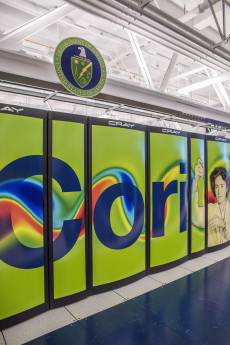2019 ALCC Program Supports 10 Research Teams With 4 Million Node-Hours at NERSC
August 7, 2019
Each year, the DOE Office of Advanced Scientific Computing Research’s (ASCR’s) Leadership Computing Challenge (ALCC) program awards computing time at ASCR’s high performance computing centers at Lawrence Berkeley, Argonne, and Oak Ridge National Laboratories to scientists from industry, academia, and national laboratories whose work emphasizes high-risk, high-payoff simulations in energy-related fields.
For the ALCC 2019-2020 campaign, ASCR received 75 proposals and, through a competitive review process, chose 37 proposals to receive allocations totaling 16.4 million node-hours. At NERSC, 10 research teams received a total of 4.1 million node-hours to use on the Cori supercomputer:
- David Trebotich (Lawrence Berkeley National Laboratory) received 860,000 node-hours for “Multiphase Flow in Shale.”
- J. Ilja Siepmann (University of Minnesota), Evgenii Fetisov (Pacific Northwest National Laboratory), Jason Goodpaster (University of Minnesota), Chris Knight (Argonne National Laboratory), Christopher Mundy (Pacific Northwest National Laboratory), and Yongchul Chung (Pusan National University) received 200,000 node-hours for “Predictive Modeling and Machine Learning for Functional Nanoporous Materials,” a Consortium/End-Station Proposal.
- Frithjof Karsch (Brookhaven National Laboratory), Swagato Mukherjee (Brookhaven National Laboratory), Alexei Bazavov (Michigan State University), Heng-Tong Ding (Central China Normal University, China), Peter Petreczky (Brookhaven National Laboratory), and Patrick Steinbrecher (Brookhaven National Laboratory) received 800,000 node-hours for “Higher order cumulants of net-charge fluctuations.”
- Aida El-Khadra (University of Illinois, Urbana-Champaign), Carleton DeTar (University of Utah), Steven Gottlieb (Indiana University), Elivra Gámiz (University of Granada), Andreas Kronfeld (Fermi National Accelerator Laboratory), John Laiho (Syracuse University), Doug Toussaint (University of Arizona), and Ruth Van de Water (Fermilab) received 330,000 node-hours for “Semileptonic B- and D-meson form factors with high precision.”
- Katherine Calvin, (Pacific Northwest National Laboratory), Dave Bader (Lawrence Livermore National Laboratory), Susannah Burrows (Pacific Northwest National Laboratory), Ruby Leung (Pacific Northwest National Laboratory), Mathew Maltrud (Los Alamos National Laboratory), Mark Taylor (Sandia National Laboratories), and Peter Thornton (Oak Ridge National Laboratory) received 490,000 node-hours for “Investigating energy-climate-biogeochemistry sensitivity with the Energy Exascale Earth System Model (E3SM).”
- Eric Lancon (Brookhaven National Laboratory), Douglas Benjamin (Argonne National Laboratory), Abid Malik (Brookhaven National Laboratory), and Paolo Calafiura (Lawrence Berkeley National Laboratory) received 400,000 node-hours for “Scaling LHC proton-proton collision simulations and Machine Learning for the ATLAS experiment.”
- Gary S. Grest (Sandia National Laboratories), Shengfeng Cheng (Virginia Polytechnic Institute and State University), Sanat Kumar (Columbia University), Dvora Perahia (Clemson University), and Michael Rubinstein (Duke University) received 270,000 node-hours for “Large Scale Numerical Simulations of Polymer Nanocomposites.”
- Stephen Jardin (Princeton Plasma Physics Laboratory), Nate Ferraro (Princeton Plasma Physics Laboratory), and Brendan Lyons (General Atomics) received 395,000 node-hours for “Study of a Disrupting Plasma in ITER.”
- Frederico Fiuza (SLAC National Accelerator Laboratory), Anna Grassi (Stanford University), and Warren Mori (University of California, Los Angeles) received 395,000 node-hours for “Large-scale kinetic simulations of particle acceleration in laser-driven shocks.”
- Darin Comeau (Los Alamos National Laboratory), Xylar Asay-Davis (Los Alamos National Laboratory), Matthew Hoffman (Los Alamos National Laboratory), Wuyin Lin (Brookhaven National Laboratory), Mark Petersen (Los Alamos National Laboratory), Stephen Price (Los Alamos National Laboratory), and Andrew Roberts (Los Alamos National Laboratory) received 360,000 node-hours for “Cryospheric Physics in E3SM: Impacts of Antarctic Ice Shelf Melting, Southern Ocean Resolution, and Sea Ice Coupling on Global Climate.”
About NERSC and Berkeley Lab
The National Energy Research Scientific Computing Center (NERSC) is a U.S. Department of Energy Office of Science User Facility that serves as the primary high performance computing center for scientific research sponsored by the Office of Science. Located at Lawrence Berkeley National Laboratory, NERSC serves almost 10,000 scientists at national laboratories and universities researching a wide range of problems in climate, fusion energy, materials science, physics, chemistry, computational biology, and other disciplines. Berkeley Lab is a DOE national laboratory located in Berkeley, California. It conducts unclassified scientific research and is managed by the University of California for the U.S. Department of Energy. »Learn more about computing sciences at Berkeley Lab.








